monochromelody
ACCESS: Confidential
- Joined
- 3 November 2015
- Messages
- 71
- Reaction score
- 194
After the end of the Second World War, the surviving Jews in the Nazi concentration camps set off a new wave of return to their hometowns and settle down in Palestine. Seeing that the time was right, Zionism began to raise up, calling on Jews living in different parts of the world to return to their hometowns, and stepped up preparations for the establishment of the Jew state.
The Palestine area originally belonged to the Ottoman Empire. Since the collapse of the Ottoman Empire after World War I, the League of Nations entrusted the British to manage it, and it is generally called the British Palestine escrow.
As far as 1920s, the local Arabs have been fighting against the Jews, both openly and secretly. When such conflicts finally intensified publicly, in September 1947, the British cabinet judged that the British army could no longer stand in Palestine, and began to prepare for its withdrawal.
At the end of 1947, the UN Resolution 181 proposed the establishment of a Jewish state in Palestine. This resolution was welcomed by the Jews, but it was inevitably resisted by the League of Arab States. Arabian militants clashed with Jewish guerrillas, and the entire Palestine was plunged into civil war.
The commander of the British Garrison immediately announced that the escrow rule would end on May 15, 1948, and the day before the end of the British escrow rule, on May 14, the Jews declared the founding of a nation, the country name Israel. The next day, the coalition forces of Egypt, Syria, Trans-Jordan, and Iraq marched into Palestine, and the first Middle East war broke out.

(Above)1948 Arab-Israel war, the first stage: from Israel announced the founding of the country, to the first ceasefire from the United Nations.
The Israeli National Defense Force (IDF) was also established when Israel was founded. This army mainly composed of Haganah and other Zionist guerrillas and Jewish soldiers or volunteers from all over the world, young and inexperienced, as well as in lacks of heavy equipment.
The Jewish guerrillas naturally have their method of gathering materials: as early as the beginning of the withdrawal of the British army, the guerrillas had already developed inside the British army, stole a lot of weapons and ammunition, and some heavy equipment, such as armored vehicles, even directly marked the price. The British Command asked the Jewish guerrillas to surrender their stolen goods, but the stolen items were limited to individuals at the grassroots of the guerrillas, the head-officials denied any accusation, the British could only suffer from dumb losses.
The British garrison is now evacuating one after another, but there are still many equipment in Haifa waiting to be transported or destroyed. The British army’s destruction procedure was simple: ammunition sank directly into Port of Haifa, while vehicles and heavy equipment were carried to nearby mountains with trailers, pushed down from the cliffs, and smashed into pieces. The guerrillas managed to bribe the personnel responsible for the destruction of the tank for £2,000, and a M4A2 Sherman tank scheduled to be destroyed was transported to Tel Aviv.
The British army originally set up a repair station in Tel Aviv. After the British army withdrew, it was controlled by Hagana. Tanks and armored vehicles are still being repaired here, but what the British sent was actually just a piece of scrap metal: the main gun and sighting system were gone, the engine could not run at all, while some suspension components and tracks were missing. The guerrilla repair squad risked engaging with the Palestinians and ran around the nearby British repair stations, collected a full truck of parts, and barely repaired the engine, suspension and sightings. On the beach near Haifa Port, the tracks were found buried by the British army, thus regaining the tank's running condition. Israel got its first tank in this way-although this tank even lacks a gun.

(Above)Israel’s first tank, the Meir, number 3999
The birth of Israeli armored forces
Newly-born Israel now under sieged by four Arab nations:
Syria in the north, has 45 Renault R35 and R39 light tanks from Vichy France, dozens of armored vehicles from Free France;
Iraq in the east, with a battalion of Italian CV35 tankettes, as well as several companies of armored vehicles;
Trans Jordan in the southeast, has several squadrons of armored vehicles; Egypt in the southwest is more powerful, with more than 200 armored vehicles, including not only various types of armored vehicles, but also light tanks obtained from the United Kingdom, Infantry tanks and Sherman tanks.
However, these armored forces have not all been invested in the war against the Jews, and Israel still has a trace of vitality.
At the beginning, the main ethnic group in the entire Palestine area was still Arabs. The Jewish settlements were scattered in areas controlled by the Arabs. The transportation of necessities for life mostly relied on the transportation convoys organized by Jews and the British.
When ethnic conflicts in Palestine have intensified, the safety of the transportation convoy has also been significantly threatened. After many negotiations, the British agreed to the Jews installing protective armor on the trucks.
After the introduction of the United Nations resolution in 1947, a full-scale conflict between Jews and Arabs was inevitable. It can be said that the original intention of the Israel Defense Forces was to maintain this series of fragile transportation lifelines. These routes runs deep into the Arabs territory, were extremely dangerous.
And when the Arabs launched a full-scale siege of Jerusalem in April 1948, opening up the supply line connecting Jerusalem became a crucial issue. Naturally, this important task was handed over to Israel's only armored force at the time, the 8th Armored Brigade.

(Above)Commander of the 8th Brigade, Colonel Yitzhak Sadeh
The 8th Armored Brigade was established on May 24, 1948, the brigade commander was Colonel Yitzhak Sadeh (1890-1952). He was originally a Russian who served in the Tsarist Russian army in his early years and participated in the First World War. Because of his age and seniority, he was given the nickname "Old Man". The 8th Brigade is based in Tel-Aviv, under its jurisdiction the 82nd Tank Battalion and the 89th Assault Battalion.
The commander of the 89th Assault Battalion was the famous Moshe Dayan (1915-1981), known for his bravery and decisiveness, a.k.a. the single-eyed general.
The commander of the 82nd Tank Battalion was Major Felix Beatus (1917-1992) from Poland, born in a Jewish family. The Beatus family originally lived in Czechoslovakia, driven to Poland by the invasion of the Nazis, then fled to the Soviet Union. During the Great Patriotic War, Felix bid farewell to his wife and children to join the Soviet Red Army, later incorporated into the newly formed Polish People's Army. He started from a truck driver to a tank driver, finally promoted to a tank brigade commander of the Polish People's Army by 1945. Ironically, even if he drove the German invaders out of Poland along with the Soviet Red Army, he was still persecuted in Poland after the war because of his Jewish descent. In 1947, he moved to Palestine with his wife and children in anger.
Considering that he studied advanced tank command courses at the Soviet Military Academy, and his rich experience in armored command, Beatus was quickly absorbed as a member of the Jewish armed organization and helped Colonel Yitzhak Sadeh establishing an armored troop school in Tel Aviv, which became the cradle of Israeli armored forces.

(Above)Yitzhak Sadeh and Felix Beatus
The 82nd Tank Battalion was formed in March 1948, at the beginning of its establishment, there were only personnel, no tanks. Felix recalled that Sadeh took him to a warehouse in Tel Aviv Port to see the 10 French Hotchkiss H35 tanks (info shows that these tanks came from Yugoslavia). These tanks were scrapped due to various malfunctions, needs a thorough repair. Sadeh told Felix that they would build a tank battalion. Felix asked, "The tank battalion needs vehicles, maintenance squads, communication equipment, ammunition and supplies. What is the use of tanks alone?" Sadeh explained: "These are the tanks in the battalion. You are the battalion commander. We managed to get together."
This battalion can be called a "Coalition force" to put it nicely. In fact, including the battalion commander, its members were collected from all over the world. There are three companies in the battalion: Company A is a Slavic company, mostly Soviet veterans of the Great Patriotic War, who only speaks Russian and a little Yiddish; Company B is an Anglo-Saxon company, mainly British, American, and Canadian with South Africans, only English is spoken; Company C is adapted from Jewish guerrillas fighting in Palestine.
Battalion Commander Felix speaks Polish, Russian, and German, but he does not speak Hebrew or English. Fortunately, the brigade commander Sadeh is a master of multi-language, and is fluent in the languages of the above-mentioned countries. In peacetime meetings, Sadeh personally communicated with the subordinate units, and during battles, the command system was equipped with interpreters to overcome the language barrier.
The French Hotchkiss tanks mentioned earlier was handed over to the Slavic company for training, after the repairs were completed. As for the Anglo-Saxon company, they first use the Sherman without a tank gun. After the tank has regained its driving ability, it is mainly used for personnel training. Therefore, it is not a big problem without decent armament. It is said that the tank is equipped with a 20mm Hispano-Suiza, which may be used for gunnery training. The tank was named Meir after one of the girlfriends of the tank crewmen.

(Above)A very rare photo that reveals the detail of the Meir’s main gun. The person in the photo is Desmond Rutledge, a tank driver of the 82nd Tank Battalion, with his wife Miriam.
Sadeh were informed that there were still several Cromwell cruiser tanks waiting to be evacuated by the British army. These tanks are in good condition, with the engines working properly, main guns and machine guns that can be fired. With fuel and ammo, even rations and radio are all available. It is natural to try to steal the tank out. The first opportunity came on May 23, 1948, when the British army would transport these tanks from the inland base to the Port of Haifa as planned. The Israelis bribed the British transport team at a price of £3,000 per tank to take over these tanks, considering that a Cromwell tank cost about £40,000, it is actually a very good price to get a tank. But unfortunately, the Israelis' actions to steal vehicles and collect equipment at the time alerted the British troops, which intensified their guard during the transportation, the plan A failed.
But there were still back-up plans available. The Israelis’ intelligence on the British military camp came from two moles they developed: Mike Flanagan and Harry McDonald. The two tankmen are Irish, and it happens that their childhood was spent in the wave of the Irish independence movement. They have natural empathy for resisting British rule and striving for sovereignty and independence. Flanagan also participated in the liberation of Bergen-Belsen concentration camp, and has strong sympathy for the Jews. The two began secretly providing weapons and equipment to the guerrillas as early as March 1948. After contacting the guerrilla intelligence agents, they learned that the Israelis were going to steal the tanks, and they soon made a plan to steal them.

(Above)Flanagan (left) and McDonald (right)
In order to prevent theft, the British cut off several cables on these Cromwell tanks in advance. However, both Flanagan and McDonald are professional tankmen. They secretly connected the cable back in no time.
According to the plan, they volunteered to apply for night shifts from June 29th to 30th to take the opportunity to pick up the drivers sent by the guerrillas and prepare to drive four tanks.
At the beginning, the operation went out smoothly, but later things went wrong. The driver sent by the guerrillas only drove Sherman tanks, came up with some troubles. One of the Cromwells could not start for a long time and had to give up, and the driver escaped from the base on foot. Another driver drove into a pit by mistake, trapped the tank, and could not get out because he could not operate the gearbox. In this operation, only two tanks were stolen, but it is better to have two tanks than nothing. The group smashed through the gates of the barracks and fled, throwing off the chasers all the way out of Haifa. The tank transporter got a flat tire or so, only a jeep came to pick them up. The tank had to follow the jeep driving south on its own tracks. The column traveled about 100 kilometers to Tel Aviv and joined the newly formed Israel Defense Forces. Due to the serious lack of experienced tankers in the Jews, Flanagan and McDonald who stole the tanks were incorporated into the 82nd Tank Battalion and fought in tanks. Flanagan served as the driver and McDonald as the tank commander.

(Above)Flanagan, with the tank he drove back to Tel Aviv. Note the combination of the type-F hull with the 75mm gun

(Above)Another tank No. 211, notice the type-C hull of this tank
Overview of Israeli tanks in 1948
As mentioned earlier, the guerrillas obtained a batch of Hotchkiss tanks and their first Sherman tank by refurbishing scrapped vehicles. However, Israel still urgently needs all kinds of armored forces and is trying to collect them from various channels. A batch of second-hand Shermans purchased from a US military base in Italy, arrived in Israel in 1948. These were about 36 tanks in this batch, all of which were equipped with 105mm howitzers. Before these Sherman tanks were sold to Israel, the gun barrels were drilled to be demilitarized. In general, this batch of broken tanks was in very poor condition and had no avalible guns. They were dismantled and overhauled as soon as they arrived in Israel.
For these Shermans, it is said that Israel purchased a batch of 77mm Krupp mountain cannons through other channels and modified them to adapt into Sherman turrets. This adaption is true, but they didn't have time: due to the massive modification work, these Krupp cannons were installed on the Sherman late in April 1949. By this time, the 1948 war had already ended, and there was no stage for these modified vehicles to appear.
There were only three Shermans who charged into the battle in 1948. These three were equipped with three M3 75mm tank guns purchased by Israel, and they were restored to normal combat conditions. However, in the initial campaign that began in July 1948, the three Sherman tanks were still in workshop restoration, thus not combat capable.
In the initial campaign, the main Israeli tanks were the Sherman tank Meir, without a proper main gun, and the aforementioned two Cromwell tanks. These two Cromwell tanks, one of which is Mk.3, equipped with a 6-pounder gun, and a Type-C hull, named as Miriam, carrying number 211. The other one is a Mk.4 type with a 75mm gun and a F-type hull, named Ruth, numbered 457.
Two names come from the wives or lovers of the crew members: Desmond Rutledge, the driver of vehicle 211, his wife's name is Miriam; the driver of vehicle 457 is Mike Flanagan who stole these tanks, after joining the Israeli army, he met his girlfriend Ruth Levy.
These tanks and soldiers later became the backbone of the IDF during the Middle East War.

(Above)Cromwell and Sherman tank in the Sinai Peninsula, 1949
Veteran's first combat
Since Jerusalem is under sieged by Jordanian army, the Israeli army needs to relief as soon as possible. David Ben-Gurion(1886-1973) knew that to open the road to Jerusalem, you must first strike on Latrun, where is occupied by Jordan Army. Since the beginning of May, the Jewish guerrillas and the army launched frequent attacks around Latrun.

(Above)May 1948, the battles around Latrun
At the end of May to early June, the army has successively adjusted four brigade's force, and launched Operation Bin Nun Alef/BET, Operation Yoram, paying hundreds of casualties, but never opened a breakthrough in Latrun. The Jordanian force in Latrun had strong firepower, with 8 25-pdr howitzer and 16 3-in mortars, having the advantages of bunkers and concrete fortress. Israeli light infantry attacks suffered heavy losses.
The UN Security Council announced a ceasefire for 4 weeks, from June 11th to July 8th, this is the first ceasefire in the 1948 war. Ben-Gurian decided to take this opportunity to get Sadeh's 8th armored brigade ready and join in the Battle of Latrun.
The 8th armored brigade is being trained in Tel Aviv. In order to advance toward Latrun, Sadeh must first strike the two strongholds in front of Tel Aviv: Lydda and Ramle. On July 10, 1948, the first ceasefire ended, and the Israeli launched a series of offensive operations, known as "10-day offensive". A series of campaign were carried out from Tel Aviv to Jerusalem, known as Operation Danny, memorating one of the victims of Convoy 35, Daniel Mass. The operation comprised with two phases: the first phase intended to capture Lydda and Ramle, to ensure the safety of Tel Aviv; the second phase intended to capture Latrun, and open the road to Jerusalem.
Lydda (today renamed as Lod) is about 15km southeast from Tel Aviv, after taking Lydda, the 8th brigade would cover the advance of the main force. According to Sadeh's plan, Felix's 82nd tank battalion would attack Lydda from the west, while Dayan's the 89th assault battalion flanking attack from the east of Lydda. The 82nd tank battalion's Anglo-Saxon company progressed smoothly, captured Lydda Airport within half an hour. But Slavic company misread the map and street sign, which failed to arrive at the attack starting position on time. Time is critical, and Dayan act against order. His battalion entered Lydda from the east, without any tank support. This rude action caused a surprising effect: the Palestinians in the city saw them coming from the east, mistakenly thought that they were Jordanian army coming for reinforcement. People rushed to the streets and cheered, running into a storm of submachine gun fire and grenades. In the battle of Lydda, about 10 Israeli soldiers were killed while taking out at least 400 Palestinians. Dayan also send his men south along the highway to Ramle, launched a fierce combat against Jordan defenders. It was at this time Dayan contacted the brigade command, reporting his action. Sadeh was mad, ordering Dayan return to his original position to cover the flank of 8th brigade. In the battle of Lydda and Ramle, Dayan's battalion suffered great losses on personnel and vehicles, while the road from Tel Aviv to Latrun was secured.
July 9-13, the first phase of Operation Danny was basically completed, but the second phase advance was hard. After days of fierce battles, Latrun was still under Jordanian army control. The UN declared second ceasefire from 19:00 on July 18. One hour before the ceasefire take effect, the 82nd tank battalion send the two Cromwell tanks into the final push toward Latrun. The two tanks' offensive start from 6 pm assisting the infantry attack. However, the Jordanian defenders fight back fiercely, as the combat begins for only 15 minutes, one Cromwell tank was hit, and the main gun failed, needs to pull back and get repair. The tank slowly reverse back, while infantries around misunderstand that the tank was about to quit the battle, so they also retreat back, the final attack failed. All five assaults failed to take Latrun, until the 1967 Six Days War did they finally succeed. Today, Latrun has become the place where the Israeli Tank Museum is located.
Two in one
The second ceasefire lasted from July 18 to October 15. Once the ceasefire was over, IDF launched Operation Yoav in the Southern front, advanced south into the Negev desert. It was intended to wedge in the Egyptian army between the coast line and the Beersheba-Hebron-Jerusalem front. IDF pushed south to Faluga, encountering Egyptian 9th Infantry Brigade. The Egyptian army gain on the concrete fortress built by the British, set up barbed wires and mine field, repulsed several attack attempts. Sadeh's 8th armoured brigade again, was called to attack the fortified area. The 82nd tank battalion supporting Negev brigade, attacked Iraq Al-Manshiyah. After well composed artillery barrage and aerial strike, the fortification was destroyed and taken. When Israelis continued pushing on toward Faluga, things went wrong again. Due to the lack of coordination, the Slavic company of 82nd went lost again, this time they found themselves trapped by minefield and anti-tank ditch, the loss is heavy. The Anglo-Saxon company's two Cromwell tanks were repelled by Egyptian gunfire, infantry accompany was forced to stop. Two tanks broke through the Egyptian barbed wire defense, only to found that there was no infantry cover behind. They cannot risks driving forward alone. In this battle, the driver Flanagan got hurt by shrapnel, and one tank got its engine failed, the other got its main gun jammed. As the repair tools were left in Lydda, they had to withdraw from subsequent operations.
As it would be difficult to advance under Egyptian gunfire without tank support, Israelis had to retreat. The Egyptian commander forcing Israeli retreat, later became the President of Egypt, Gamal Abdel Nasser, a.k.a. "Faluga's Tiger".
After the battle, the two Cromwell tanks faced a difficult situation: for vehicle 211 Miriam, the 6-pdr gun was destroyed, but the chassis part is in good condition; for vehicle 457 Ruth the engine is damaged, but the turret is still operational. The Israeli had to make a choise: exchange their turrets. After the exchange, Miliam chassis carrying Ruth turret would continued to fight, what the remaining left as "organ donor", to removed certain parts to keep another vehicle running.

(Above)Two Cromwell tanks just exchanged their turrets. Hebrew written on the hull is Miiliam, and the turret carrying number 457.
The three Sherman tanks mentioned earlier joined the battle and got their name: Tamar, Ruth II, Ada. The Meir get back to the second line at this time, no longer participating first-line combat.

(Above)Tamar, this tank is extremely easy to recognize, because its Hebrew name were written on both sides of the turret.
In the coming November and December, three Israeli Shelman tanks and the hybrid Cromwell tank participated in many combat operations, eliminated the Egyptian M22 tanks in the Negev Desert.

(Above)An Egyptian M22 light tank captured by IDF
Ending
Compared to the Sherman tanks continued servicing in the IDF, Cromwell tank retired after the 1948 war, and no longer participated in combat. Today, these two tanks still parking in the Latrun tank museum for tourists.

(Above)The Miriam chassis with Ruth turret is relatively complete and intact, althought some external stowage bin and other features gone.

(Above)The other one, Ruth chassis with Miriam turret, shows more traces of war period. The engine deck is lost, a sheet of steel plate is simply welded as cover, the inside of the engine room may also be empty. The gun is a dummy, with a 17-pdr gun tube welded to the front. The bow BESA gun was also missing, replaced by a steel pipe.
The most weird feature of this vehicle is that the F-type chassis of late model Cromwell carrying a 6-pdr turret of early model, although this is the result of hasty field recovery work.

In 1978 when Israel came to its 30th anniversary of establishment, the first domestic tank Merkava Mk.1 was first debuted, with a Cromwell tank. This tank is the combination of two tanks that driven from Haifa military base 30 years ago. From Tel Aviv to Latrun, from Negev to Sinai Peninsula, it carried a generation of suffering and the memory of the country's foundation.
Today, Israeli tankers still wear a Cromwell tank badge on their berets, engraved with a motto: "People in Tanks will win."

The Palestine area originally belonged to the Ottoman Empire. Since the collapse of the Ottoman Empire after World War I, the League of Nations entrusted the British to manage it, and it is generally called the British Palestine escrow.
As far as 1920s, the local Arabs have been fighting against the Jews, both openly and secretly. When such conflicts finally intensified publicly, in September 1947, the British cabinet judged that the British army could no longer stand in Palestine, and began to prepare for its withdrawal.
At the end of 1947, the UN Resolution 181 proposed the establishment of a Jewish state in Palestine. This resolution was welcomed by the Jews, but it was inevitably resisted by the League of Arab States. Arabian militants clashed with Jewish guerrillas, and the entire Palestine was plunged into civil war.
The commander of the British Garrison immediately announced that the escrow rule would end on May 15, 1948, and the day before the end of the British escrow rule, on May 14, the Jews declared the founding of a nation, the country name Israel. The next day, the coalition forces of Egypt, Syria, Trans-Jordan, and Iraq marched into Palestine, and the first Middle East war broke out.
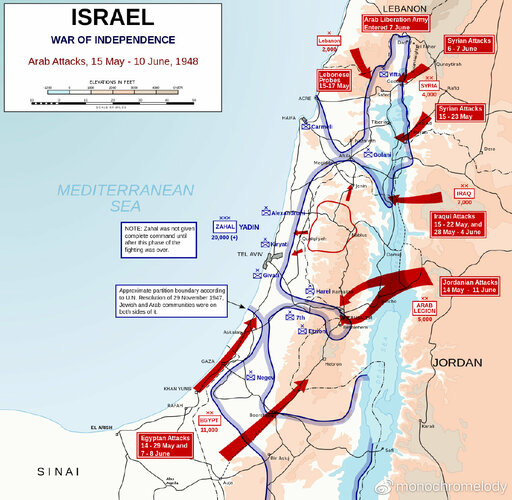
(Above)1948 Arab-Israel war, the first stage: from Israel announced the founding of the country, to the first ceasefire from the United Nations.
The Israeli National Defense Force (IDF) was also established when Israel was founded. This army mainly composed of Haganah and other Zionist guerrillas and Jewish soldiers or volunteers from all over the world, young and inexperienced, as well as in lacks of heavy equipment.
The Jewish guerrillas naturally have their method of gathering materials: as early as the beginning of the withdrawal of the British army, the guerrillas had already developed inside the British army, stole a lot of weapons and ammunition, and some heavy equipment, such as armored vehicles, even directly marked the price. The British Command asked the Jewish guerrillas to surrender their stolen goods, but the stolen items were limited to individuals at the grassroots of the guerrillas, the head-officials denied any accusation, the British could only suffer from dumb losses.
The British garrison is now evacuating one after another, but there are still many equipment in Haifa waiting to be transported or destroyed. The British army’s destruction procedure was simple: ammunition sank directly into Port of Haifa, while vehicles and heavy equipment were carried to nearby mountains with trailers, pushed down from the cliffs, and smashed into pieces. The guerrillas managed to bribe the personnel responsible for the destruction of the tank for £2,000, and a M4A2 Sherman tank scheduled to be destroyed was transported to Tel Aviv.
The British army originally set up a repair station in Tel Aviv. After the British army withdrew, it was controlled by Hagana. Tanks and armored vehicles are still being repaired here, but what the British sent was actually just a piece of scrap metal: the main gun and sighting system were gone, the engine could not run at all, while some suspension components and tracks were missing. The guerrilla repair squad risked engaging with the Palestinians and ran around the nearby British repair stations, collected a full truck of parts, and barely repaired the engine, suspension and sightings. On the beach near Haifa Port, the tracks were found buried by the British army, thus regaining the tank's running condition. Israel got its first tank in this way-although this tank even lacks a gun.
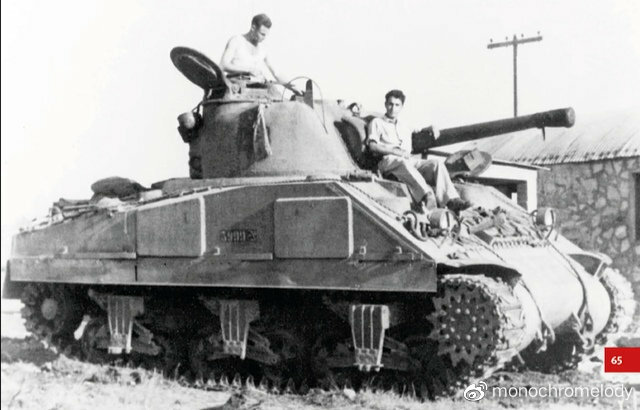
(Above)Israel’s first tank, the Meir, number 3999
The birth of Israeli armored forces
Newly-born Israel now under sieged by four Arab nations:
Syria in the north, has 45 Renault R35 and R39 light tanks from Vichy France, dozens of armored vehicles from Free France;
Iraq in the east, with a battalion of Italian CV35 tankettes, as well as several companies of armored vehicles;
Trans Jordan in the southeast, has several squadrons of armored vehicles; Egypt in the southwest is more powerful, with more than 200 armored vehicles, including not only various types of armored vehicles, but also light tanks obtained from the United Kingdom, Infantry tanks and Sherman tanks.
However, these armored forces have not all been invested in the war against the Jews, and Israel still has a trace of vitality.
At the beginning, the main ethnic group in the entire Palestine area was still Arabs. The Jewish settlements were scattered in areas controlled by the Arabs. The transportation of necessities for life mostly relied on the transportation convoys organized by Jews and the British.
When ethnic conflicts in Palestine have intensified, the safety of the transportation convoy has also been significantly threatened. After many negotiations, the British agreed to the Jews installing protective armor on the trucks.
After the introduction of the United Nations resolution in 1947, a full-scale conflict between Jews and Arabs was inevitable. It can be said that the original intention of the Israel Defense Forces was to maintain this series of fragile transportation lifelines. These routes runs deep into the Arabs territory, were extremely dangerous.
And when the Arabs launched a full-scale siege of Jerusalem in April 1948, opening up the supply line connecting Jerusalem became a crucial issue. Naturally, this important task was handed over to Israel's only armored force at the time, the 8th Armored Brigade.
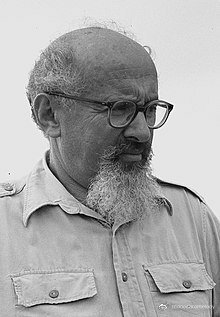
(Above)Commander of the 8th Brigade, Colonel Yitzhak Sadeh
The 8th Armored Brigade was established on May 24, 1948, the brigade commander was Colonel Yitzhak Sadeh (1890-1952). He was originally a Russian who served in the Tsarist Russian army in his early years and participated in the First World War. Because of his age and seniority, he was given the nickname "Old Man". The 8th Brigade is based in Tel-Aviv, under its jurisdiction the 82nd Tank Battalion and the 89th Assault Battalion.
The commander of the 89th Assault Battalion was the famous Moshe Dayan (1915-1981), known for his bravery and decisiveness, a.k.a. the single-eyed general.
The commander of the 82nd Tank Battalion was Major Felix Beatus (1917-1992) from Poland, born in a Jewish family. The Beatus family originally lived in Czechoslovakia, driven to Poland by the invasion of the Nazis, then fled to the Soviet Union. During the Great Patriotic War, Felix bid farewell to his wife and children to join the Soviet Red Army, later incorporated into the newly formed Polish People's Army. He started from a truck driver to a tank driver, finally promoted to a tank brigade commander of the Polish People's Army by 1945. Ironically, even if he drove the German invaders out of Poland along with the Soviet Red Army, he was still persecuted in Poland after the war because of his Jewish descent. In 1947, he moved to Palestine with his wife and children in anger.
Considering that he studied advanced tank command courses at the Soviet Military Academy, and his rich experience in armored command, Beatus was quickly absorbed as a member of the Jewish armed organization and helped Colonel Yitzhak Sadeh establishing an armored troop school in Tel Aviv, which became the cradle of Israeli armored forces.
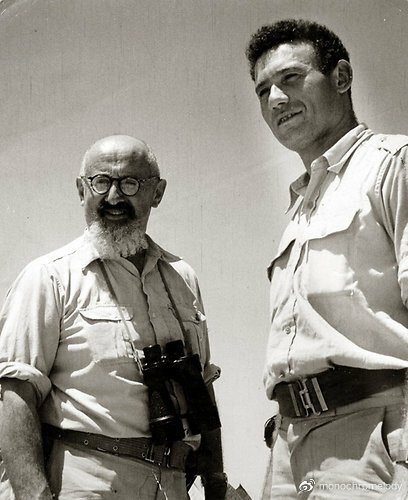
(Above)Yitzhak Sadeh and Felix Beatus
The 82nd Tank Battalion was formed in March 1948, at the beginning of its establishment, there were only personnel, no tanks. Felix recalled that Sadeh took him to a warehouse in Tel Aviv Port to see the 10 French Hotchkiss H35 tanks (info shows that these tanks came from Yugoslavia). These tanks were scrapped due to various malfunctions, needs a thorough repair. Sadeh told Felix that they would build a tank battalion. Felix asked, "The tank battalion needs vehicles, maintenance squads, communication equipment, ammunition and supplies. What is the use of tanks alone?" Sadeh explained: "These are the tanks in the battalion. You are the battalion commander. We managed to get together."
This battalion can be called a "Coalition force" to put it nicely. In fact, including the battalion commander, its members were collected from all over the world. There are three companies in the battalion: Company A is a Slavic company, mostly Soviet veterans of the Great Patriotic War, who only speaks Russian and a little Yiddish; Company B is an Anglo-Saxon company, mainly British, American, and Canadian with South Africans, only English is spoken; Company C is adapted from Jewish guerrillas fighting in Palestine.
Battalion Commander Felix speaks Polish, Russian, and German, but he does not speak Hebrew or English. Fortunately, the brigade commander Sadeh is a master of multi-language, and is fluent in the languages of the above-mentioned countries. In peacetime meetings, Sadeh personally communicated with the subordinate units, and during battles, the command system was equipped with interpreters to overcome the language barrier.
The French Hotchkiss tanks mentioned earlier was handed over to the Slavic company for training, after the repairs were completed. As for the Anglo-Saxon company, they first use the Sherman without a tank gun. After the tank has regained its driving ability, it is mainly used for personnel training. Therefore, it is not a big problem without decent armament. It is said that the tank is equipped with a 20mm Hispano-Suiza, which may be used for gunnery training. The tank was named Meir after one of the girlfriends of the tank crewmen.
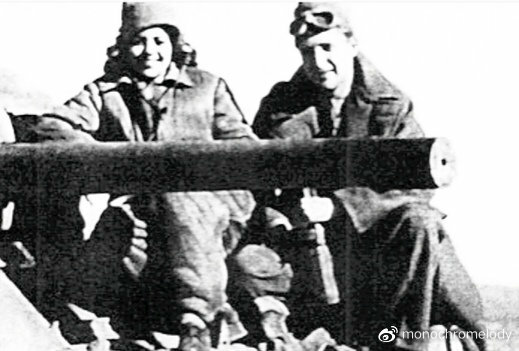
(Above)A very rare photo that reveals the detail of the Meir’s main gun. The person in the photo is Desmond Rutledge, a tank driver of the 82nd Tank Battalion, with his wife Miriam.
Sadeh were informed that there were still several Cromwell cruiser tanks waiting to be evacuated by the British army. These tanks are in good condition, with the engines working properly, main guns and machine guns that can be fired. With fuel and ammo, even rations and radio are all available. It is natural to try to steal the tank out. The first opportunity came on May 23, 1948, when the British army would transport these tanks from the inland base to the Port of Haifa as planned. The Israelis bribed the British transport team at a price of £3,000 per tank to take over these tanks, considering that a Cromwell tank cost about £40,000, it is actually a very good price to get a tank. But unfortunately, the Israelis' actions to steal vehicles and collect equipment at the time alerted the British troops, which intensified their guard during the transportation, the plan A failed.
But there were still back-up plans available. The Israelis’ intelligence on the British military camp came from two moles they developed: Mike Flanagan and Harry McDonald. The two tankmen are Irish, and it happens that their childhood was spent in the wave of the Irish independence movement. They have natural empathy for resisting British rule and striving for sovereignty and independence. Flanagan also participated in the liberation of Bergen-Belsen concentration camp, and has strong sympathy for the Jews. The two began secretly providing weapons and equipment to the guerrillas as early as March 1948. After contacting the guerrilla intelligence agents, they learned that the Israelis were going to steal the tanks, and they soon made a plan to steal them.
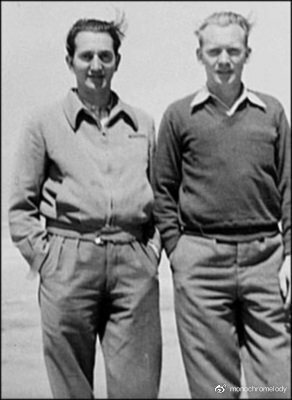
(Above)Flanagan (left) and McDonald (right)
In order to prevent theft, the British cut off several cables on these Cromwell tanks in advance. However, both Flanagan and McDonald are professional tankmen. They secretly connected the cable back in no time.
According to the plan, they volunteered to apply for night shifts from June 29th to 30th to take the opportunity to pick up the drivers sent by the guerrillas and prepare to drive four tanks.
At the beginning, the operation went out smoothly, but later things went wrong. The driver sent by the guerrillas only drove Sherman tanks, came up with some troubles. One of the Cromwells could not start for a long time and had to give up, and the driver escaped from the base on foot. Another driver drove into a pit by mistake, trapped the tank, and could not get out because he could not operate the gearbox. In this operation, only two tanks were stolen, but it is better to have two tanks than nothing. The group smashed through the gates of the barracks and fled, throwing off the chasers all the way out of Haifa. The tank transporter got a flat tire or so, only a jeep came to pick them up. The tank had to follow the jeep driving south on its own tracks. The column traveled about 100 kilometers to Tel Aviv and joined the newly formed Israel Defense Forces. Due to the serious lack of experienced tankers in the Jews, Flanagan and McDonald who stole the tanks were incorporated into the 82nd Tank Battalion and fought in tanks. Flanagan served as the driver and McDonald as the tank commander.
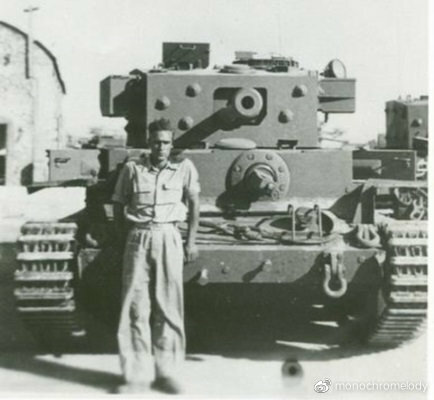
(Above)Flanagan, with the tank he drove back to Tel Aviv. Note the combination of the type-F hull with the 75mm gun
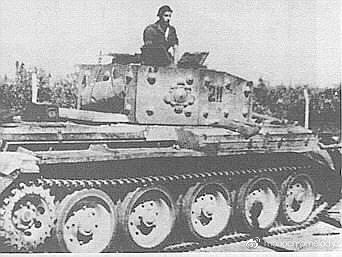
(Above)Another tank No. 211, notice the type-C hull of this tank
Overview of Israeli tanks in 1948
As mentioned earlier, the guerrillas obtained a batch of Hotchkiss tanks and their first Sherman tank by refurbishing scrapped vehicles. However, Israel still urgently needs all kinds of armored forces and is trying to collect them from various channels. A batch of second-hand Shermans purchased from a US military base in Italy, arrived in Israel in 1948. These were about 36 tanks in this batch, all of which were equipped with 105mm howitzers. Before these Sherman tanks were sold to Israel, the gun barrels were drilled to be demilitarized. In general, this batch of broken tanks was in very poor condition and had no avalible guns. They were dismantled and overhauled as soon as they arrived in Israel.
For these Shermans, it is said that Israel purchased a batch of 77mm Krupp mountain cannons through other channels and modified them to adapt into Sherman turrets. This adaption is true, but they didn't have time: due to the massive modification work, these Krupp cannons were installed on the Sherman late in April 1949. By this time, the 1948 war had already ended, and there was no stage for these modified vehicles to appear.
There were only three Shermans who charged into the battle in 1948. These three were equipped with three M3 75mm tank guns purchased by Israel, and they were restored to normal combat conditions. However, in the initial campaign that began in July 1948, the three Sherman tanks were still in workshop restoration, thus not combat capable.
In the initial campaign, the main Israeli tanks were the Sherman tank Meir, without a proper main gun, and the aforementioned two Cromwell tanks. These two Cromwell tanks, one of which is Mk.3, equipped with a 6-pounder gun, and a Type-C hull, named as Miriam, carrying number 211. The other one is a Mk.4 type with a 75mm gun and a F-type hull, named Ruth, numbered 457.
Two names come from the wives or lovers of the crew members: Desmond Rutledge, the driver of vehicle 211, his wife's name is Miriam; the driver of vehicle 457 is Mike Flanagan who stole these tanks, after joining the Israeli army, he met his girlfriend Ruth Levy.
These tanks and soldiers later became the backbone of the IDF during the Middle East War.
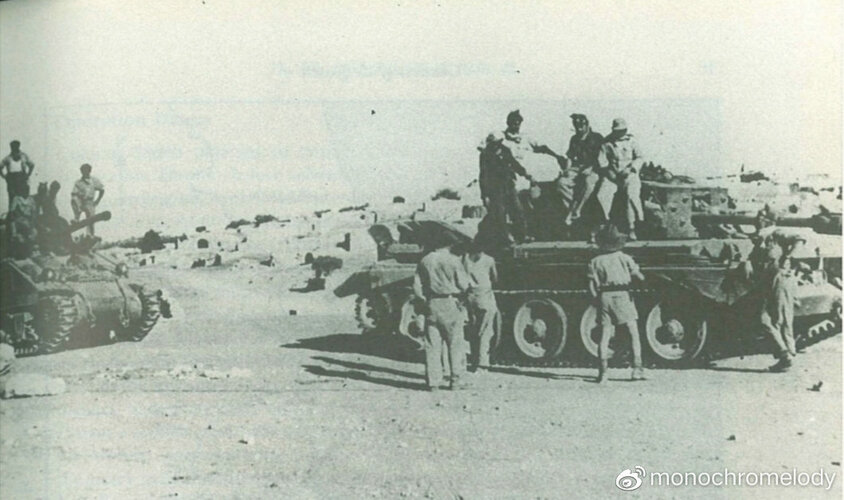
(Above)Cromwell and Sherman tank in the Sinai Peninsula, 1949
Veteran's first combat
Since Jerusalem is under sieged by Jordanian army, the Israeli army needs to relief as soon as possible. David Ben-Gurion(1886-1973) knew that to open the road to Jerusalem, you must first strike on Latrun, where is occupied by Jordan Army. Since the beginning of May, the Jewish guerrillas and the army launched frequent attacks around Latrun.
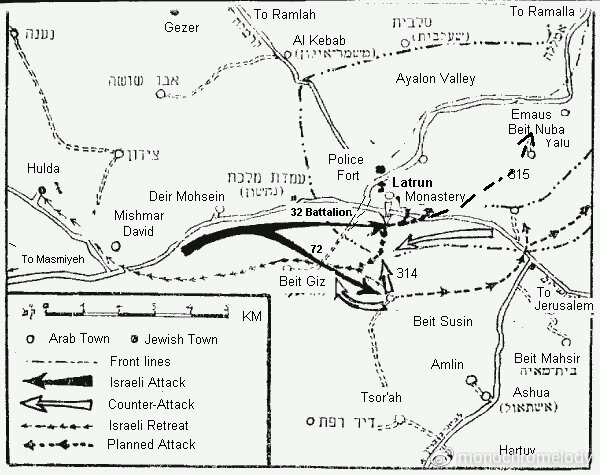
(Above)May 1948, the battles around Latrun
At the end of May to early June, the army has successively adjusted four brigade's force, and launched Operation Bin Nun Alef/BET, Operation Yoram, paying hundreds of casualties, but never opened a breakthrough in Latrun. The Jordanian force in Latrun had strong firepower, with 8 25-pdr howitzer and 16 3-in mortars, having the advantages of bunkers and concrete fortress. Israeli light infantry attacks suffered heavy losses.
The UN Security Council announced a ceasefire for 4 weeks, from June 11th to July 8th, this is the first ceasefire in the 1948 war. Ben-Gurian decided to take this opportunity to get Sadeh's 8th armored brigade ready and join in the Battle of Latrun.
The 8th armored brigade is being trained in Tel Aviv. In order to advance toward Latrun, Sadeh must first strike the two strongholds in front of Tel Aviv: Lydda and Ramle. On July 10, 1948, the first ceasefire ended, and the Israeli launched a series of offensive operations, known as "10-day offensive". A series of campaign were carried out from Tel Aviv to Jerusalem, known as Operation Danny, memorating one of the victims of Convoy 35, Daniel Mass. The operation comprised with two phases: the first phase intended to capture Lydda and Ramle, to ensure the safety of Tel Aviv; the second phase intended to capture Latrun, and open the road to Jerusalem.
Lydda (today renamed as Lod) is about 15km southeast from Tel Aviv, after taking Lydda, the 8th brigade would cover the advance of the main force. According to Sadeh's plan, Felix's 82nd tank battalion would attack Lydda from the west, while Dayan's the 89th assault battalion flanking attack from the east of Lydda. The 82nd tank battalion's Anglo-Saxon company progressed smoothly, captured Lydda Airport within half an hour. But Slavic company misread the map and street sign, which failed to arrive at the attack starting position on time. Time is critical, and Dayan act against order. His battalion entered Lydda from the east, without any tank support. This rude action caused a surprising effect: the Palestinians in the city saw them coming from the east, mistakenly thought that they were Jordanian army coming for reinforcement. People rushed to the streets and cheered, running into a storm of submachine gun fire and grenades. In the battle of Lydda, about 10 Israeli soldiers were killed while taking out at least 400 Palestinians. Dayan also send his men south along the highway to Ramle, launched a fierce combat against Jordan defenders. It was at this time Dayan contacted the brigade command, reporting his action. Sadeh was mad, ordering Dayan return to his original position to cover the flank of 8th brigade. In the battle of Lydda and Ramle, Dayan's battalion suffered great losses on personnel and vehicles, while the road from Tel Aviv to Latrun was secured.
July 9-13, the first phase of Operation Danny was basically completed, but the second phase advance was hard. After days of fierce battles, Latrun was still under Jordanian army control. The UN declared second ceasefire from 19:00 on July 18. One hour before the ceasefire take effect, the 82nd tank battalion send the two Cromwell tanks into the final push toward Latrun. The two tanks' offensive start from 6 pm assisting the infantry attack. However, the Jordanian defenders fight back fiercely, as the combat begins for only 15 minutes, one Cromwell tank was hit, and the main gun failed, needs to pull back and get repair. The tank slowly reverse back, while infantries around misunderstand that the tank was about to quit the battle, so they also retreat back, the final attack failed. All five assaults failed to take Latrun, until the 1967 Six Days War did they finally succeed. Today, Latrun has become the place where the Israeli Tank Museum is located.
Two in one
The second ceasefire lasted from July 18 to October 15. Once the ceasefire was over, IDF launched Operation Yoav in the Southern front, advanced south into the Negev desert. It was intended to wedge in the Egyptian army between the coast line and the Beersheba-Hebron-Jerusalem front. IDF pushed south to Faluga, encountering Egyptian 9th Infantry Brigade. The Egyptian army gain on the concrete fortress built by the British, set up barbed wires and mine field, repulsed several attack attempts. Sadeh's 8th armoured brigade again, was called to attack the fortified area. The 82nd tank battalion supporting Negev brigade, attacked Iraq Al-Manshiyah. After well composed artillery barrage and aerial strike, the fortification was destroyed and taken. When Israelis continued pushing on toward Faluga, things went wrong again. Due to the lack of coordination, the Slavic company of 82nd went lost again, this time they found themselves trapped by minefield and anti-tank ditch, the loss is heavy. The Anglo-Saxon company's two Cromwell tanks were repelled by Egyptian gunfire, infantry accompany was forced to stop. Two tanks broke through the Egyptian barbed wire defense, only to found that there was no infantry cover behind. They cannot risks driving forward alone. In this battle, the driver Flanagan got hurt by shrapnel, and one tank got its engine failed, the other got its main gun jammed. As the repair tools were left in Lydda, they had to withdraw from subsequent operations.
As it would be difficult to advance under Egyptian gunfire without tank support, Israelis had to retreat. The Egyptian commander forcing Israeli retreat, later became the President of Egypt, Gamal Abdel Nasser, a.k.a. "Faluga's Tiger".
After the battle, the two Cromwell tanks faced a difficult situation: for vehicle 211 Miriam, the 6-pdr gun was destroyed, but the chassis part is in good condition; for vehicle 457 Ruth the engine is damaged, but the turret is still operational. The Israeli had to make a choise: exchange their turrets. After the exchange, Miliam chassis carrying Ruth turret would continued to fight, what the remaining left as "organ donor", to removed certain parts to keep another vehicle running.
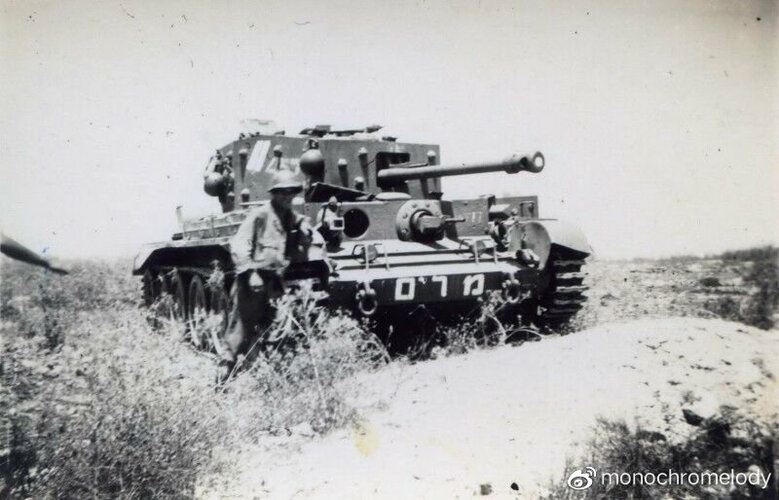
(Above)Two Cromwell tanks just exchanged their turrets. Hebrew written on the hull is Miiliam, and the turret carrying number 457.
The three Sherman tanks mentioned earlier joined the battle and got their name: Tamar, Ruth II, Ada. The Meir get back to the second line at this time, no longer participating first-line combat.
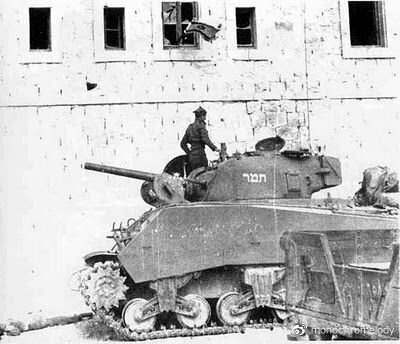
(Above)Tamar, this tank is extremely easy to recognize, because its Hebrew name were written on both sides of the turret.
In the coming November and December, three Israeli Shelman tanks and the hybrid Cromwell tank participated in many combat operations, eliminated the Egyptian M22 tanks in the Negev Desert.
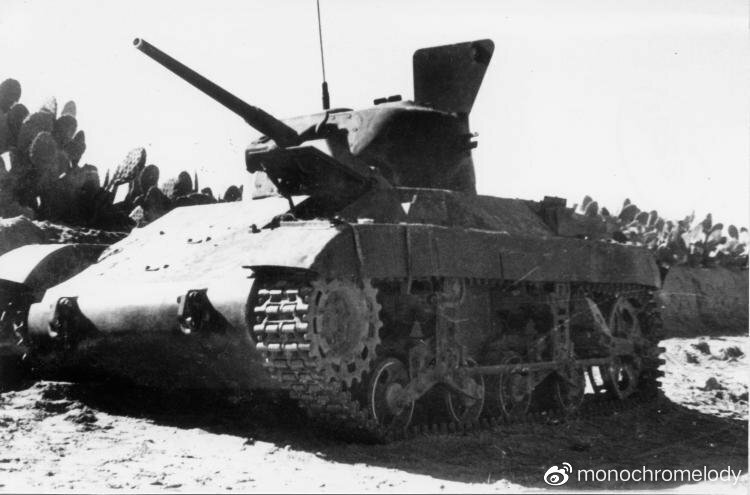
(Above)An Egyptian M22 light tank captured by IDF
Ending
Compared to the Sherman tanks continued servicing in the IDF, Cromwell tank retired after the 1948 war, and no longer participated in combat. Today, these two tanks still parking in the Latrun tank museum for tourists.
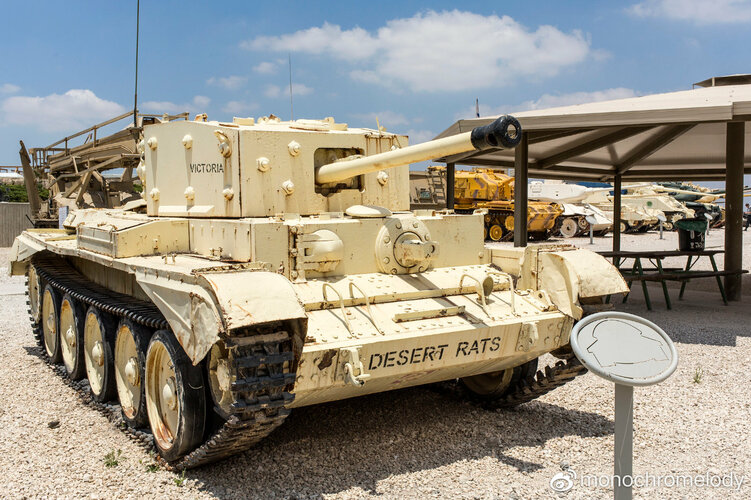
(Above)The Miriam chassis with Ruth turret is relatively complete and intact, althought some external stowage bin and other features gone.
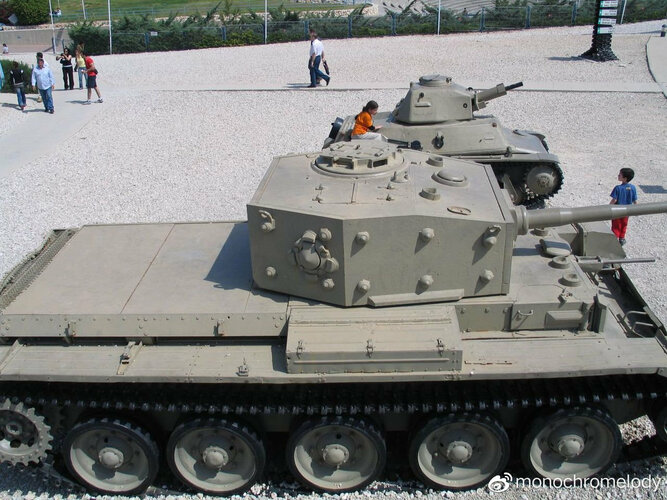
(Above)The other one, Ruth chassis with Miriam turret, shows more traces of war period. The engine deck is lost, a sheet of steel plate is simply welded as cover, the inside of the engine room may also be empty. The gun is a dummy, with a 17-pdr gun tube welded to the front. The bow BESA gun was also missing, replaced by a steel pipe.
The most weird feature of this vehicle is that the F-type chassis of late model Cromwell carrying a 6-pdr turret of early model, although this is the result of hasty field recovery work.
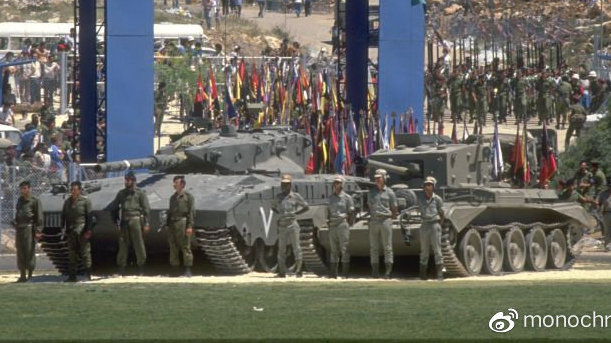
In 1978 when Israel came to its 30th anniversary of establishment, the first domestic tank Merkava Mk.1 was first debuted, with a Cromwell tank. This tank is the combination of two tanks that driven from Haifa military base 30 years ago. From Tel Aviv to Latrun, from Negev to Sinai Peninsula, it carried a generation of suffering and the memory of the country's foundation.
Today, Israeli tankers still wear a Cromwell tank badge on their berets, engraved with a motto: "People in Tanks will win."
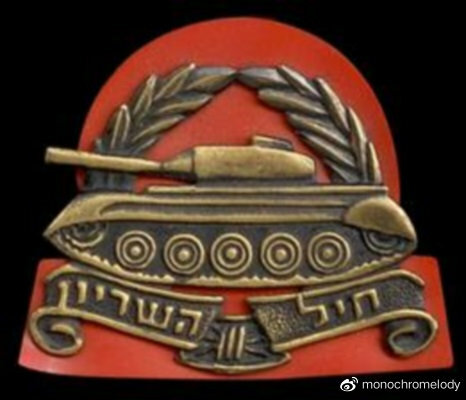
Last edited:
